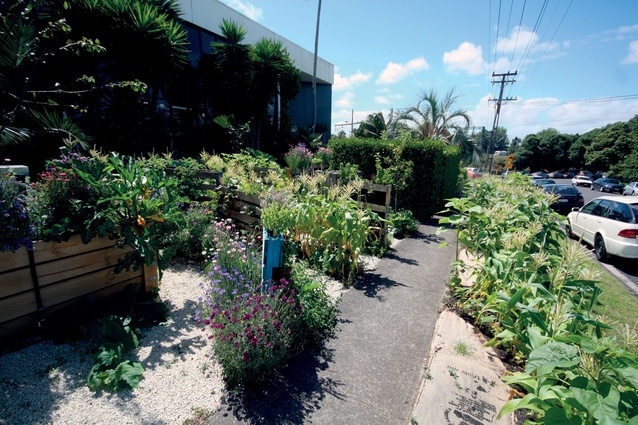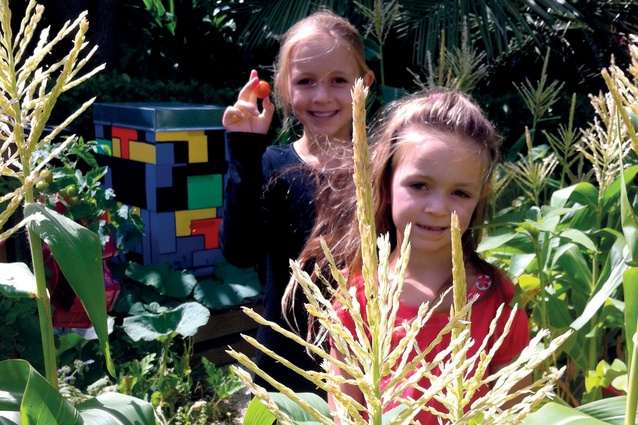Urban connection
Urban agriculture is quickly becoming a trending topic in the rapid densification of our living environments. In cities around the world, more and more people are creating productive landscapes; growing food on walls, roofs and marginalised spaces across the urban landscape. As our cities continue to densify, urbanites are becoming increasingly educated about resource consumption and food security, as well as the vital role productive landscapes play in the health of our living environments. At some point, urban productive landscapes will reach a capacity where they add resilience to the health and wellbeing of a city’s occupants.
Across the Auckland Isthmus, ‘pop’ up landscapes, gardens, green roofs and green walls are firmly nestled into our city landscape, one by one reversing the loss of biodiversity, resources and energy consumption that urbanisation and swelling populations can produce, and slowly contributing towards a resilient urban landscape. Aucklanders have a long history of connectivity with their natural environment so it comes as no surprise that urban agriculture is trending across the city.
In late 2013 Natural Habitats put their stake in the ground, quite literally, in the move towards productive urban landscapes by installing an almost entirely recycled and edible garden in the land and berm formerly separating their offices from the adjacent road. This simple act of claiming marginalised land has propelled this garden well and truly into the realm of landscape architectural discourse; posing questions about urban land use, land ownership, land responsibility and the line that separates public and private property.
In this context, the landscape, collaboratively created with lead designer Tash Geelen, is both provocateur for questioning appropriate land use and reconciler in producing a response to the emerging repercussions associated with the densification of our cities, such as resource scarcity, diminished biodiversity, or the disconnection between humans and nature. The timing of the project could not have been better, coinciding with Auckland Council’s new found stance on berm maintenance, transforming the installation from an otherwise act of rebellion into an experiment in land appropriation and custodianship.
By all accounts, the resulting garden is a public space. From its early conception, the site was designed with inclusiveness in mind, inviting visitors to taste, smell and pick, enveloping the public path and reminding passers-by that the natural environment is all around us; a contrast from the dividing line typical of many public/private interfaces. While blurring the boundaries of ownership, this project contributes to ventures across the city, which prioritise human engagement.
It is also intent on being ‘green’. With product and material consumption at an all-time global high, a key objective for the brief was to recycle and reuse as many materials as possible, and in doing so, the project utilises old packing palettes as fully irrigated ‘green walls’; a mechanism for maximising productivity in the available space.
Reversing the loss of biodiversity long associated with the urban environment, and critical for food productivity, pollinators, birds and bees, is a combination of companion planting and hand painted beehives. The companion planting manages unwanted pests, keeping the garden organic and pesticide free, while the bees contribute significantly to pollination processes - the unique painted finish considered to assist the bees with way finding.
Complimenting the soft landscape components is a selection of feature art projects including a scarecrow created by students at Cockle Bay School, which was also constructed from recycled materials, to ward off the less desirable members of the food chain.
Completing the project are successional planting plans, which will establish a shifting state of growth throughout the year as the seasons transition. One of the great qualities of the typology of edibles is that they are perhaps the most visible reminder of the temporality of our natural environment; the growth and production rates quite literally changing colour, shape and form on a daily basis.
It is from this position that green spaces - landscapes, gardens, green walls, green roofs and the like - serve most profoundly as visible expressions of our natural environment.
By nature, landscapes are transitional, and the visibility of this changing state, particularly against the backdrop of the city, provides opportunities to connect back to the natural systems that surround us.
In this way, this, and many other pop-up landscapes across the city, are generating some momentum toward resilience in the urban realm; reducing resource consumption, increasing biodiversity, increasing food security, providing education, and, above all else, connecting humans with their environments, which in essence is the foundation for the ethos of landscape architecture.
Not bad for a ‘garden’.













